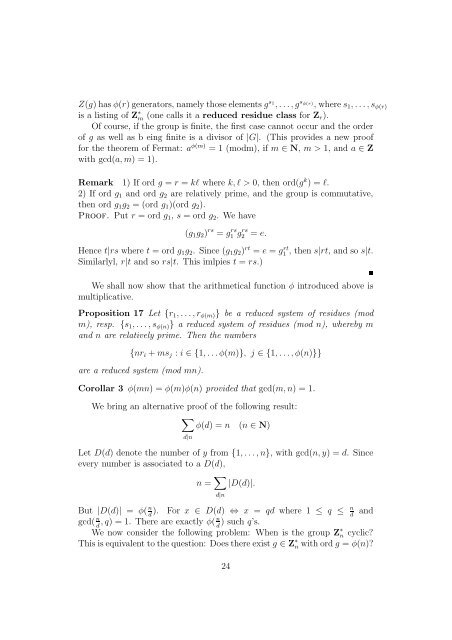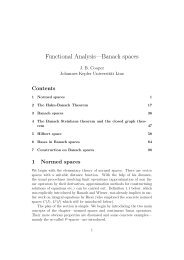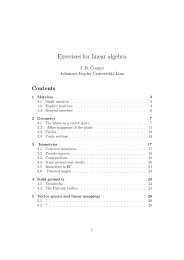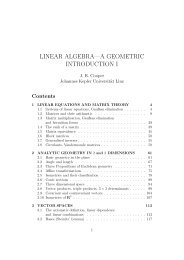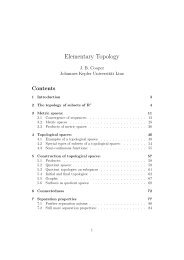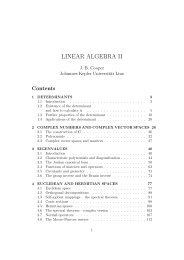Number theory, geometry and algebra - Dynamics-approx.jku.at
Number theory, geometry and algebra - Dynamics-approx.jku.at
Number theory, geometry and algebra - Dynamics-approx.jku.at
You also want an ePaper? Increase the reach of your titles
YUMPU automatically turns print PDFs into web optimized ePapers that Google loves.
Z(g)hasφ(r)gener<strong>at</strong>ors, namelythoseelementsg s 1<br />
,...,g s φ(r) ,wheres1 ,...,s φ(r)<br />
is a listing of Z ∗ m (one calls it a reduced residue class for Z r).<br />
Of course, if the group is finite, the first case cannot occur <strong>and</strong> the order<br />
of g as well as b eing finite is a divisor of |G|. (This provides a new proof<br />
for the theorem of Ferm<strong>at</strong>: a φ(m) = 1 (modm), if m ∈ N, m > 1, <strong>and</strong> a ∈ Z<br />
with gcd(a,m) = 1).<br />
Remark 1) If ord g = r = kl where k,l > 0, then ord(g k ) = l.<br />
2) If ord g 1 <strong>and</strong> ord g 2 are rel<strong>at</strong>ively prime, <strong>and</strong> the group is commut<strong>at</strong>ive,<br />
then ord g 1 g 2 = (ord g 1 )(ord g 2 ).<br />
Proof. Put r = ord g 1 , s = ord g 2 . We have<br />
(g 1 g 2 ) rs = g rs<br />
1 g rs<br />
2 = e.<br />
Hence t|rs where t = ord g 1 g 2 . Since (g 1 g 2 ) rt = e = g1 rt , then s|rt, <strong>and</strong> so s|t.<br />
Similarlyl, r|t <strong>and</strong> so rs|t. This imlpies t = rs.)<br />
We shall now show th<strong>at</strong> the arithmetical function φ introduced above is<br />
multiplic<strong>at</strong>ive.<br />
Proposition 17 Let {r 1 ,...,r φ(m) } be a reduced system of residues (mod<br />
m), resp. {s 1 ,...,s φ(n) } a reduced system of residues (mod n), whereby m<br />
<strong>and</strong> n are rel<strong>at</strong>ively prime. Then the numbers<br />
{nr i +ms j : i ∈ {1,...φ(m)}, j ∈ {1,...,φ(n)}}<br />
are a reduced system (mod mn).<br />
Corollar 3 φ(mn) = φ(m)φ(n) provided th<strong>at</strong> gcd(m,n) = 1.<br />
We bring an altern<strong>at</strong>ive proof of the following result:<br />
∑<br />
φ(d) = n (n ∈ N)<br />
d|n<br />
Let D(d) denote the number of y from {1,...,n}, with gcd(n,y) = d. Since<br />
every number is associ<strong>at</strong>ed to a D(d),<br />
n = ∑ d|n<br />
|D(d)|.<br />
But |D(d)| = φ( n). For x ∈ D(d) ⇔ x = qd where 1 ≤ q ≤ n <strong>and</strong><br />
d d<br />
gcd( n,q) = 1. There are exactly d φ(n ) such q’s.<br />
d<br />
We now consider the following problem: When is the group Z ∗ n cyclic?<br />
Thisisequivalent tothequestion: Doesthereexistg ∈ Z ∗ n withordg = φ(n)?<br />
24


